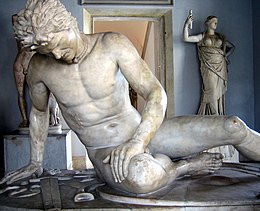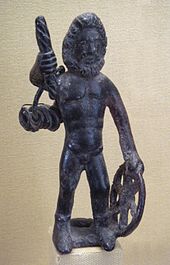Gauls
By the 4th century BC, they were spread over much of what is now France, Belgium,[1] Switzerland, Southern Germany, Austria, and the Czech Republic,[1] by virtue of controlling the trade routes along the river systems of the Rhône, Seine, Rhine, and Danube.[1] After the end of the First Punic War, the rising Roman Republic increasingly put pressure on the Gallic sphere of influence.The Gauls were made up of many tribes (toutās), many of whom built large fortified settlements called oppida (such as Bibracte), and minted their own coins.[2][3] Linguist Václav Blažek has argued that Irish gall ('foreigner') and Welsh gâl ('enemy, hostile') may be later adaptations of the ethnic name Galli that were introduced to the British Isles during the 1st millennium AD.[5] The spread of iron working led to the Hallstatt culture in the 8th century BC; the Proto-Celtic language is often thought to have been spoken around this time.Although the momentum of the invasion was broken, the Galatians were by no means exterminated, and continued to demand tribute from the Hellenistic states of Anatolia to avoid war.According to Pausanias, soon after arrival the Celts plotted “to seize Egypt”, and so Ptolemy marooned them on a deserted island in the Nile River.In the settlement of 64 BC, Galatia became a client state of the Roman empire, the old constitution disappeared, and three chiefs (wrongly styled "tetrarchs") were appointed, one for each tribe.But this arrangement soon gave way before the ambition of one of these tetrarchs, Deiotarus, a contemporary of Cicero and Julius Caesar, who made himself master of the other two tetrarchies and was finally recognized by the Romans as 'king' of Galatia.Caesar's motivation for the invasion seems to have been his need for gold to pay off his debts and for a successful military expedition to boost his political career.[13] First-century BC Greek historian Diodorus Siculus described them as tall, generally heavily built, very light-skinned, and light-haired, with long hair and mustaches: The Gauls are tall of body, with rippling muscles, and white of skin, and their hair is blond, and not only naturally so, but they make it their practice to increase the distinguishing color by which nature has given it.Hence some have supposed that from these lands the island received its inhabitants.Tacitus noted the Caledonians had "red hair and large limbs" which he felt pointed to a "Germanic origin."[15] Jordanes describes the physical attributes of the Gauls as including "reddish hair and large loose-jointed bodies.Also there existed highly developed population centers, called oppida by Caesar, such as Bibracte, Gergovia, Avaricum, Alesia, Bibrax, Manching and others.Most had contact with Roman merchants and some, particularly those that were governed by Republics such as the Aedui, Helvetii and others, had enjoyed stable political alliances with Rome.[18] La Tène metalwork in bronze, iron and gold, developing technologically out of the Hallstatt culture, is stylistically characterized by "classical vegetable and foliage motifs such as leafy palmette forms, vines, tendrils and lotus flowers together with spirals, S-scrolls, lyre and trumpet shapes".[19] Such decoration may be found on fine bronze vessels, helmets and shields, horse trappings, and elite jewelry, especially torcs and fibulae.Early on, La Tène style adapted ornamental motifs from foreign cultures into something distinctly new; the complicated brew of influences include Scythian art as well as that of the Greeks and Etruscans, among others.Caesar divided the people of Gaulia Comata into three broad groups: the Aquitani; Galli (who in their own language were called Celtae); and Belgae.Of all these, the Belgae are the bravest, because they are furthest from the civilisation and refinement of (our) Province, and merchants least frequently resort to them, and import those things which tend to effeminate the mind; and they are the nearest to the Germani, who dwell beyond the Rhine, with whom they are continually waging war; for which reason the Helvetii also surpass the rest of the Gauls in valour, as they contend with the Germani in almost daily battles, when they either repel them from their own territories, or themselves wage war on their frontiers.Aquitania extends from the Garonne to the Pyrenees and to that part of the Atlantic (Bay of Biscay) which is near Spain: it looks between the setting of the sun, and the north star.Other pan-regional deities include the horned god Cernunnos, the horse and fertility goddess Epona, Ogmios, Sucellos[30][31] and his companion Nantosuelta.Diodorus says they believed souls were reincarnated after a certain number of years, probably after spending time in an afterlife, and noted they buried grave goods with the dead.[30] Celtic peoples often made votive offerings: treasured items deposited in water and wetlands, or in ritual shafts and wells, often in the same place over generations.[39][40] The Roman conquest gave rise to a syncretic Gallo-Roman religion, with deities such as Lenus Mars, Apollo Grannus, and the pairing of Rosmerta with Mercury.An iconic phrase summarizing this view is that of "our ancestors the Gauls" (nos ancêtres les Gaulois), associated with the history textbook for schools by Ernest Lavisse (1842–1922), who taught that "the Romans established themselves in small numbers; the Franks were not numerous either, Clovis having but a few thousand men with him.Similarly, in Swiss national historiography of the 19th century, the Gaulish Helvetii were chosen as representing the ancestral Swiss population (compare Helvetia as national allegory), as the Helvetii had settled in both the French and the German-speaking parts of Switzerland, and their Gaulish language set them apart from Latin- and German-speaking populations in equal measure.A genetic study published in PLOS One in December 2018 examined 45 individuals buried at a La Téne necropolis in Urville-Nacqueville, France.[44] A genetic study published in the Journal of Archaeological Science in October 2019 examined 43 maternal and 17 paternal lineages for the La Téne necropolis in Urville-Nacqueville, France, and 27 maternal and 19 paternal lineages for La Téne tumulus of Gurgy ‘Les Noisats’ near modern Paris, France.The evidence suggested that the Gauls of the La Téne culture largely evolved from local Bronze Age populations.









Dying GaulAncient GreekCelticmainland EuropeIron AgeRoman periodGaulishcontinental Celtic languageLa Tène cultureFranceBelgiumSwitzerlandSouthern GermanyAustriaCzech RepublicRhôneDanubeNorthern ItalyCisalpine GaulRoman–Gallic warsinto the Balkanswar with the GreeksAnatoliaTurkeyGalatiansFirst Punic WarRoman Republicsphere of influenceBattle of TelamonGallic WarsRoman provinceGallo-Roman cultureoppidaBibracteminted their own coinsmilitary operationsBrennusVercingetorixancient Celtic religiondruidsColigny calendarethnonymOld BretonBrittonicregular developmentMiddle WelshMiddle BretonCornishGalátaiGallitaeFrenchVáclav BlažekBritish IslesCaesarGallia CelticaCeltaeHallstatt cultureUrnfield cultureIndo-European-speaking peopleiron workingProto-Celtic languageEtruscanMediterraneaninvaded RomePo Valleydefeated Roman forces in a battleSicilyeastward expansionCarthagePunic WarsMercenary WarAutaritusGallic invasion of the BalkansCerethriosBrennosBolgiosIllyriaThraceAsia MinorCentral AnatoliaGalatiawar elephantsSeleucidAntiochus IHellenisticEastern MediterraneanPtolemaic EgyptPtolemy II PhiladelphusMacedonianPtolemy KeraunosSosthenesBolgiusThermopylaePersianBattle of ThermopylaeDelphiCeltic swordscabbardGalatian WarNicomedes I of BithyniaTrocmiTolistobogiiTectosagesPtolemaicPausaniasNile RiverRaphiaPtolemy IV PhilopatorAntiochus HieraxAttalus I of PergamumBattle of the Caecus RiverGnaeus Manlius VulsoPonticMithridatic Warsclient stateDeiotarusCiceroJulius Caesar'king' of GalatiaGalatian languageSecond Punic WarHannibalbattle of CannaeMassiliaGallia NarbonensisGallia Belgica

